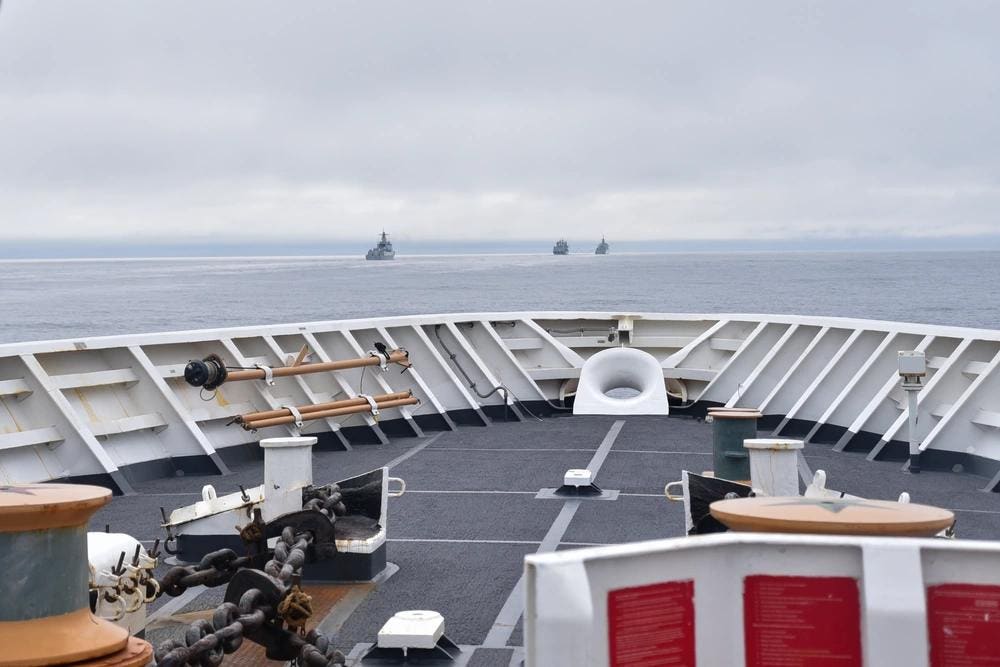In a well-coordinated media push, Alaska’s two Senators revealed that, in early August, eleven Russian and Chinese naval combatants, monitored by no less than four U.S. destroyers and a P-8 Orion maritime patrol aircraft, ventured near Alaska’s Aleutian Islands. When asked, the Pentagon offered little additional context on the maritime confrontation.
After a decade of shrugging off similar-but-smaller incursions around Alaska, a robust Pentagon response to such provocations was overdue. But, again, in the Pacific, the U.S. miliary is struggling to fully leverage the interface between raw military power, strategy, and strategic civilian communications.
The Pentagon is always loathe to discuss operations. But, in a rather odd stance, the Pentagon refused to release any information about the route the combined Chinese and Russian fleet employed while operating near Alaska. The unnecessary secrecy put the Senator’s concerning statements into question, and stood as a jarring contrast to how Taiwan, Japan and other U.S. partners openly address Chinese and Russian maritime incursions. Both countries release maps and broad tracking data to the media or use Instagram and social media sites to show where Chinese and Russian military units are operating.
Surprisingly, the Pentagon also failed to highlight contributions that other Pacific allies made in tracking the combined Russo/Chinese fleet. Japanese forces had tracked elements of the big fleet before it headed to waters off Alaska, and America’s decision to not comment on an ally’s contributions was a lost opportunity to emphasize the type of collaborative support Pacific Democracies can offer each other.
The Pentagon, when queried, passed the buck to the U.S. Northern Command, which, in turn, failed to immediately take an opportunity to explain the omissions.
Allies and Openness:
While American politicians lauded the Navy’s robust response, the Pentagon’s refusal to provide basic tracking data, combined with the Pentagon’s failure to recognize allied contributions, sends a terrible signal to other Pacific states.
At best, the Pentagon is failing to adhere to America’s established strategic guidance.
The Indo-Pacific Strategy of the United States is straightforward, emphasizing the importance of alliances, and identifying “our network of security alliances and partnerships” as “our single greatest asymmetric strength.” It also champions freedom of information in ensuring the “region remains open and accessible” and that the “region’s seas and skies are governed and used according to international law.”
In this case, America gave local alliances short shrift. On July 20, while speaking at the Aspen Security Forum, the Commander of the U.S. Indo-Pacific Command, Admiral John C. Aquilino, noted “a Russian and Chinese maritime Task Force is doing a combined patrol.” He didn’t mention that several Japanese Maritime Self-Defense Force ships and aircraft were already monitoring the nascent Russo-Chinese fleet, and that tracking and other data had likely been passed between the two partners, enabling seamless surveillance.
The Pentagon’s reticence is tough to defend. Across the Pacific, weak and small island democracies are staking their security on both alliances and openness. This is exactly where America should be leading the way.
The Philippines, in particular, is relying on a new strategy to publicize aggressive actions by Chinese forces in the South China Sea. By quickly and publicly releasing basic information on Chinese habits—operational norms known to military professionals and other observers for decades—the Philippines is now far more interested pushing back on China’s excessive territorial claims, and willing to support wider U.S.-led defense initiatives in the Pacific.
Rather than support the Philippines by following their example, the Pentagon refused to offer any detail on where the Russian and Chinese fleet went. This secrecy goes against standard public communications practices throughout the Pacific. When Russian or Chinese forces operate near Taiwan and Japan, both governments release basic tracking information, detailing the nearby platforms and their operations.
Unless the America’s maritime domain awareness capabilities off Alaska have completely decayed to the point where we cannot track nearby military vessels, America’s reticence is unnecessary. The Pentagon obviously monitored the combined Chinese and Russian fleet. And, while some means employed to track the vessels were certainly classified, the commercial imagery and other unclassified sensors available to the Pentagon—along with the “Mark 1” eyeballs aboard the naval units dispatched to shadow the intrusive fleet—should be enough to provide the public some basic unclassified tracking data.
This should be routine and easy to do. Over the past few years, the United States has put an enormous amount of energy and time into determining how classified information can be quickly declassified or downgraded so time-sensitive information can safely flow to less secure partners.
Like it or not, the public is a security partner. Aside from the help public can provide in encouraging proactive defense policies, getting basic information to the public is a perfect opportunity to test the Pentagon’s system for information dissemination. If the U.S. military cannot effectively compile and distribute time-sensitive information within the space of a single news cycle, the Pentagon has a lot more strategic communications work to do.
Why Information Matters:
Understanding just where China’s fleet went is important for Americans to understand. The Aleutians are an enormously strategic set of islands, guarding the passage into an increasingly important Arctic. In the Cold War, the U.S. military maintained several bases across the islands.
In the contested Pacific of the future, these islands will be on the front lines of any conflict.
Rather than take the expensive steps needed to start re-securing these strategic islands, America’s once-formidable Cold War outposts on the Aleutians are continuing to decay. Unpopular postings, where the erratic weather, ever-changing sea conditions, and corrosive, wind-blown salt spray made operations and maintenance a challenge, the military facilities were quickly closed after the Cold War ended, and the Pentagon, with America’s Pacific maritime leaders enjoying comfortable postings in bases on Hawaii, in San Diego or in urban Japan, is uneager to send major assets to the Aleutians anytime soon.
America’s military presence on the Aleutians has dwindled away to almost nothing. A small contingent of contractors kill time at Shemya Island, operating a little-used 10,000-foot airstrip and some important surveillance and communications systems. On the nearby islands of Amchitka, Attu and Adak, abandoned or “civilianized” military airstrips and port facilities slumber away. Other unpopulated but strategically placed islands sit, forlorn and largely forgotten.
With the closest major U.S. Navy outpost some 2,000 miles away, in Yokosuka, Japan, it is important for the public and policymakers to gain an understanding of how Russia and China are operating in the area. If the Aleutians need to be secured, America had best start now, before our relative absence tempts China or Russia to try and shift the status quo.
The failure to acknowledge key allies and align public tracking information with data already released by Indo-Pacific partners is a problem. If the U.S. Northern Command is to play a greater role in describing Chinese and Russian incursions near America’s coast, it may need to get a better understanding of America’s Pacific Strategy and move beyond the sludgy silence it seems to prefer.
This isn’t to say America’s response was poor. After largely shrugging off Chinese and Russian incursions near Alaska over the last decade, deploying four destroyers as an escort was overdue. Force is a great morale boost—particularly for a Combatant Commander whose replacement was named months ahead of schedule—but if America wants to get serious about securing the Pacific, it needs to look beyond the dispatch of a few destroyers and work to better fuse the civilian pieces of the Pacific’s “Arsenal of Democracy” with wider strategic military priorities.
The combined Russian/Chinese incursion through Alaskan waters, while troubling, was an interesting opportunity. The White House must now determine if the Pentagon and the military leaders in the Pacific made the most of it.
Read the full article here





